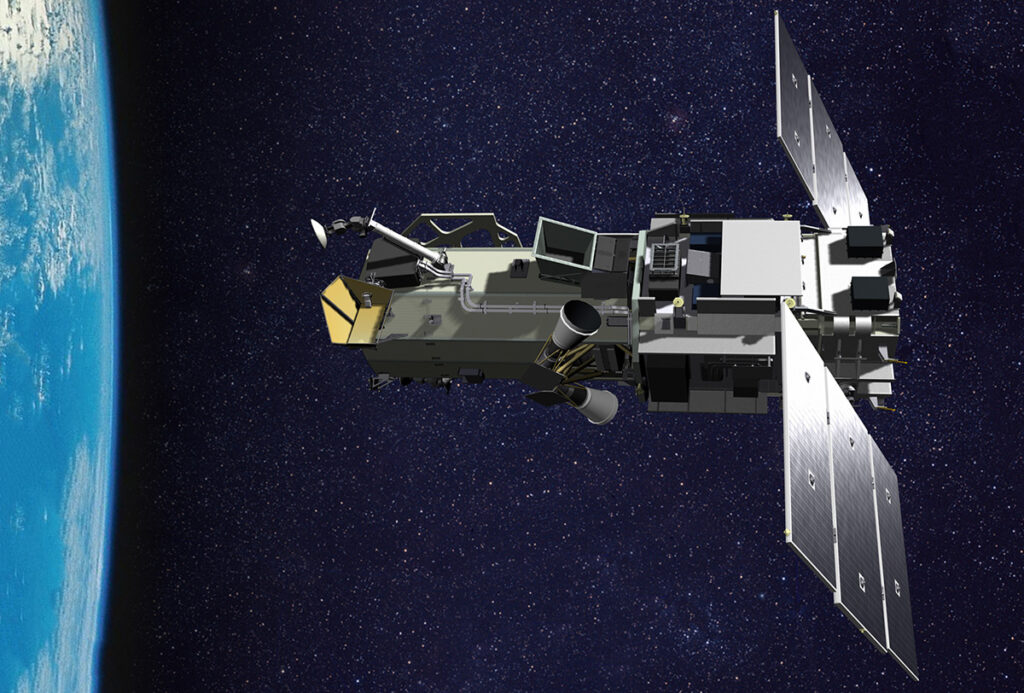
WorldView-3 remote sensing satellite, built by the former Digital Globe, now Maxar Technologies.
SATELLITE 2020: Industry hopes that long-promised revisions to US licensing requirements for remote sensing satellites would finally be wrapped this month are almost certainly going to be dashed.
Insiders say that, despite almost a year of interagency wrangling, the draft rules are extremely unlikely to be announced at the upcoming March 24 meeting of the National Space Council headed by Vice President Mike Pence — with a decision perhaps kicked back to as late as early September.
“Nothing is finalized yet,” said one official involved.
US government and industry officials tell me there continue to be major disagreements between DoD, the Department of Commerce and the State Department over how far to relax current restrictions on sales of satellite-based imagery, as well as about which agency has what authorities to say yes or no.
The revision of the commercial remote sensing rules was mandated by the White House in the May 2018 Space Policy Directive-2 (SPD-2), as part of the Trump Administration’s wider effort to cut red tape and promote commercial space industry innovation. Commerce was put in the lead.
To that end, the original draft of the new rules — issued by Commerce on May 14, 2019 — would work with a presumption of approval, in contrast to the current process, which requires specific DoD and State Dept. approval for each license. In essence, the new rules would create a form of ‘generic’ license for most remote sensing activities, while applying a more robust process for those found to be of potential national security concern.
On the other hand, that draft would have left current rules on sharing data from synthetic aperture radar (SAR) satellites (able to track ground targets), and cameras in space for space situational awareness (SSA) operations, more or less untouched — in large part due to DoD pressure. DoD also pushed back on the fact that the process would have changed the current system so that Commerce — not the Pentagon — had the final say on what capabilities would be licensed for commercial sale.
Specifically, the May draft would have limited resolution of SAR data collection to 0.25 meters, and banned any transmission of SAR data outside the US.
It further would have placed a 0.5 meter cap on satellite imaging of other spacecraft, and barred such imaging unless written permission is obtained from the operator of the spacecraft to be imaged. Further, sales of imagery of objects not included in the US military’s public space object catalog, via the website Space-Track.org, would continue to be outlawed.
While Commerce has been especially vocal about its intent to help indigenous industry providing SSA services capture more of the global market, companies in that field widely express deep concern about any restrictions on sales of ‘pictures’ of active satellites and (apparent) space debris.
DoD and the Intelligence Community — as well as some US allies — traditionally have been leery about allowing such imagery to be sold on the market because of a desire to conceal the activities, and characteristics, of their classified satellites. (Some of which, by the way, may mimic space debris in order to passively collect data.)
“Around the world, there are other systems out there that aren’t limited to the rules of the US,” one industry official said. “You can’t hide very well” in space, the official added. “So, I think the government is going to have to get over that and recognize space is a free place.”
Indeed, outcry from a wide swath of commercial industry pushed the draft regulations back to the drawing board early last summer. As I reported back in December, the draft rules were kicked upstairs to the level of department secretaries for resolution. My current readout from sources is that Commerce has made an attempt to assuage industry concerns. But, that apparently has contributed to the continued stalemate.
While industry officials have said they’ve been told DoD has softened on Commerce having the last word on licensing, I’m hearing from insiders that at the senior policy level DoD officials are not at all copacetic with the proposed rules. Certain factions among the “Deep DoD” — those with ties to the Intelligence Community — are already planning to slow roll the changes if they get approved by the White House.
The State Department also has been keen to ensure that its own equities in dealing with foreign policy on the issue are upheld, but by and large has been okay with easing restrictions to meet foreign capabilities in remote sensing, as well as for SSA.
Bottom line: don’t hold your breath. Any changes to the current situation are likely ‘still a ways away,’ as the old REM song goes.
Air Force picks Anduril, General Atomics for next round of CCA work
The two vendors emerged successful from an original pool of five and are expected to carry their drone designs through a prototyping phase that will build and test aircraft.


























